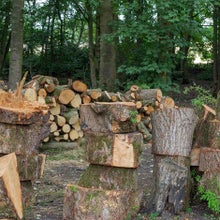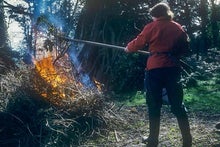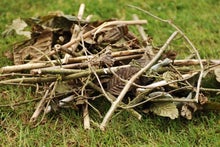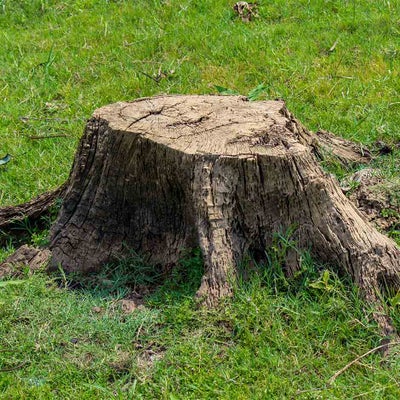
Quick facts
Trees may need removing if they are damaged, diseased, unmanageable, unwanted or have died
Dead trees are an important wildlife habitat; leaving them in place encourages fungi, bryophytes, invertebrates, birds and bats
It is prudent to completely remove trees killed by root disease, to reduce the risk of the disease spreading to other plants
Small trees and their stumps can be removed by hand, or you can hire machinery
The easiest and safest way to remove whole trees and large tree stumps is to hire a professional
Removing trees generates lots of green waste; most can be reused or recycled in the garden
Some tree roots will inevitably be left in the ground, but will eventually rot down
Do I need to remove a dead tree?
In most cases, it is not necessary to remove a dead tree, and standing dead wood is incredibly valuable to wildlife.
Before deciding to leave a dead tree in situ, it is advisable to have it assessed for stability and safety by a tree consultant. It may be necessary to thin or lower the canopy or remove splayed or leaning branches to reduce the risk of them falling during high winds. When shortening or removing limbs, aim to leave a jagged cut as this better allows water and organic matter to collect, hastening decomposition and attracting wildlife. Periodically re-assess the tree to ensure it remains safe.
If you dislike the look of dead trees but would still like to encourage wildlife, consider hiring a ‘chainsaw artist’ to turn the stump into a sculpture. Alternatively, plant a vigorous climber, like a rose or clematis, to climb up the tree and smother it in flowers.
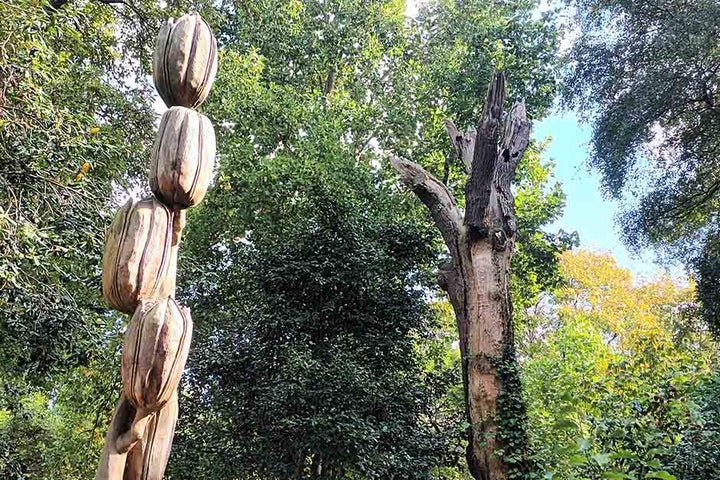
There are around 2000 saproxylic invertebrates (those that depend on dead or decaying wood, or other organisms that do) in the UK. These include detritivores like woodlice, springtails and millipedes as well as wood-boring beetles, whose larvae feed on dead wood as they tunnel through it.
These invertebrates, as well as wood-decaying fungi, recycle by releasing them back into the soil. Dead wood invertebrates also provide food for insect-eating birds like woodpeckers, nuthatches and treecreepers.
Dead wood is a valuable habitat and may be colonised by many different species of liverworts, lichens and mosses. The crevices that develop in dead wood provide nesting and roosting sites for bats and birds, and the tunnels created by wood-boring beetles may be used by cavity-nesting solitary bees, such as red mason and leaf-cutting bees.

If you can’t or don’t wish to leave a dead tree standing, consider pruning it down to a stump and leaving this to slowly instead. This method still attracts a wide variety of invertebrates, fungi and bryophytes, and the stump can be hidden from view by planting, if preferred. Bear in mind that some ailing trees will send up suckers when pruned hard, and these will need removing.
Top Tip
It may occasionally be necessary to remove a live tree, for example where it has grown unmanageable, is causing structural damage or is in the way of building work. While you may not be able to leave the stump of these trees for wildlife, you can still use the resulting green waste in a wildlife and environmentally friendly way. Consider replanting a new tree in your garden to compensate.
Do I need to remove a diseased tree?
If you have a tree that was ailing and has died, it is a good idea to confirm the cause of death and, if it is a disease, to understand how it spreads before deciding whether to leave or remove the tree. Our website has pages on common plant diseases or, if you are an RHS member, you can use the Gardening Advice service for help with disease identification.
Soil-borne diseases, such as phytophthora root rot, verticillium wilt and honey fungus, can remain in the soil after a plant has died and potentially spread to other plants, so it is advisable to remove a tree, its stump and large roots if a soil-borne disease is the culprit.
If honey fungus is suspected or confirmed but you have not lost other plants to similar symptoms, it is likely that the tree died from a weaker species of honey fungus. In this case, research suggests it is best to leave the tree in situ as it can deter stronger, pathogenic species. If you have lost multiple plants, it is likely that a pathogenic species is present, and it would be advisable to remove it to reduce the amount of fungus in the soil and give it less resource to infect other plants.
Most other serious tree diseases, such as silver leaf, fireblight and bacterial canker, spread by airborne propagules which may still be released from infections in the branches and upper trunk of a dead or dying tree. It is therefore advisable to reduce trees with these diseases down to a stump, to limit the risk of them spreading.
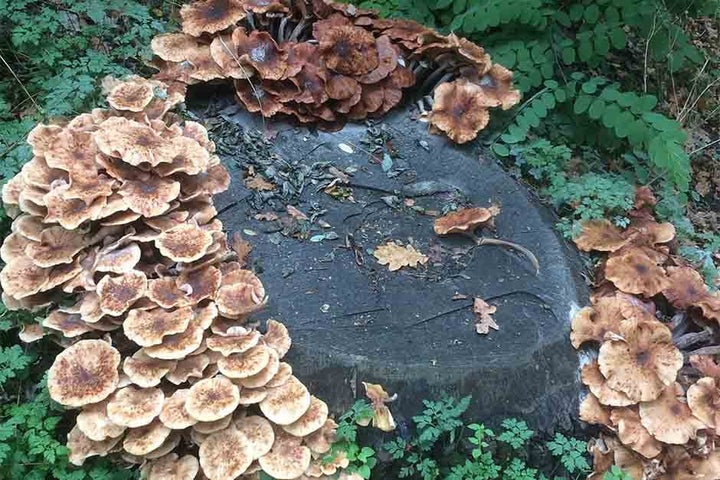
How to remove a tree or stump
If it is necessary to completely remove a tree, start by reducing the crown to leave a length of trunk 1.2m (4ft) above ground level, as this helps provide leverage when removing it. Work inwards and downwards from the tips of the tree, cutting and removing branches in manageable sections using a pruning saw or chainsaw. Once you are left with a long stump, you have the following options:
- Dig the stump out by hand – the stump and main roots of small trees can usually be dug out using a pickaxe and sharp spade. Leave attached a length of trunk so you can rock the stump back and forth and loosen roots, pruning any you unearth with loppers or a small saw until the stump comes free.
- Hire a professional – qualified tree surgeons can remove trees and their stumps quickly and safely, as well as process or take away the resulting . Although stump removal is usually done at the same time as tree felling, it can be arranged separately. Use the Arboricultural Association to find qualified tree surgeons near you, contacting at least a few to get an average price for the work.
- Winch out the stump – the stumps of small trees can be pulled from the ground with a winch. When hiring a winch, ensure you choose one with a load capacity suitable for the size of stump you are removing.
- Use a mini-excavator – an option for larger stumps that would be difficult to remove by hand. These can be hired from a local plant hire company, often with or without an operator. Ensure you have sufficient access for the excavator, especially if the stump is in your back garden. As tracked wheels can damage lawns, it is advisable to lay ground protection mats or boards and manoeuvre the vehicle onto these.
- Use a stump grinder – these machines grind down a stump and main root plate, leaving fine sawdust. Shallow grinding (to 20-25cm below ground level) is normally sufficient for laying turf over; deeper grinding (to at least 30cm) is needed for replanting or landscaping.

Safety first
Winches, mini-excavators and stump grinders are potentially hazardous and should only be hired if you are confident that you can use them safely. If you decide to tackle a stump yourself, ensure you garden safely, wearing safety footwear, thick gloves and eye protection. If in any doubt, hire a trained professional.
Should I use a weedkiller?
No – although it takes time and effort to remove a stump, it can be done using non-chemical methods.
Stump killers are strong weedkillers with big environmental impacts. The RHS does not support the use of weedkillers and recommends that alternative control methods are used. However, we do note that when gardeners struggle to remove stumps with cultural methods, regulated weedkillers for home gardeners are available for use legally. Garden centres and large retailers selling weedkillers have trained staff who can advise on suitable products for your needs.
What to do with the green waste
If you have tackled tree or stump removal yourself, you will likely be left with a large hole in the ground, a large quantity of wood and/or sawdust and a lawn or border in need of repair.
To get rid of wood and sawdust:
- Cut the branches and trunk into logs – use a chainsaw or bow saw to cut the wood into manageable pieces. Those from healthy trees can be stacked in a corner to create dead wood habitat for wildlife, stored under cover for 6-18 months and used as fuel or even used to create garden furniture, border edging or play equipment.
- Create a stumpery – for a larger feature, lay the entire stump on its side on the soil, position it to best show off the unique shape of the roots, bury it slightly and plant around it. Our page on stumperies gives more inspiration and advice.
- Recycle roots – thick roots from healthy trees can be added to a log pile for wildlife. Smaller roots can either be added to your council green waste recycling bin (check what is accepted beforehand) or taken to your local waste recycling centre. Thin roots cut into short lengths can be added to a home compost bin.
- or with sawdust – small amounts of sawdust can be added to a home compost bin, layering it between green (leafy) waste material. The easiest way to use larger quantities is as a thin mulch on well-established beds. If the sawdust comes from a mature tree, pile it in a sheltered part of the garden and let it age for 3-4 months before use. Alternatively, put sawdust in your bin or take it to your local waste recycling centre.

For more advice, see our handy guides:
Did you know?
It is best to avoid using sawdust to fill the hole left by a tree stump. Sawdust, like other woody waste, can cause nitrogen ‘lock-up’ if dug into the soil, potentially causing nutrient deficiency in plants grown there for up to two years. Sawdust is best avoided even if you don’t wish to plant anything there, as it will rot down over time, lowering the ground level.
To repair and prepare the ground for replanting or landscaping:
- Fill the hole with topsoil – use good quality, peat-free topsoil to fill in the hole left by the tree stump. Tread it down, rake it level and leave to settle for a few weeks, topping up the soil level to match the surrounding ground if necessary.
- Repair a damaged lawn – if your lawn became shredded, punctured or heavily compacted during stump removal, it may need re-levelling, or repairing with new seed or turf to return it to its original condition. Our guide on repairing lawns has lots of useful advice.
- Relieve border compaction – if the tree stump was removed from within a border, the surrounding soil is likely to have been compacted during removal work. Use a border fork to loosen the soil and work in a few bucketfuls of organic matter.











